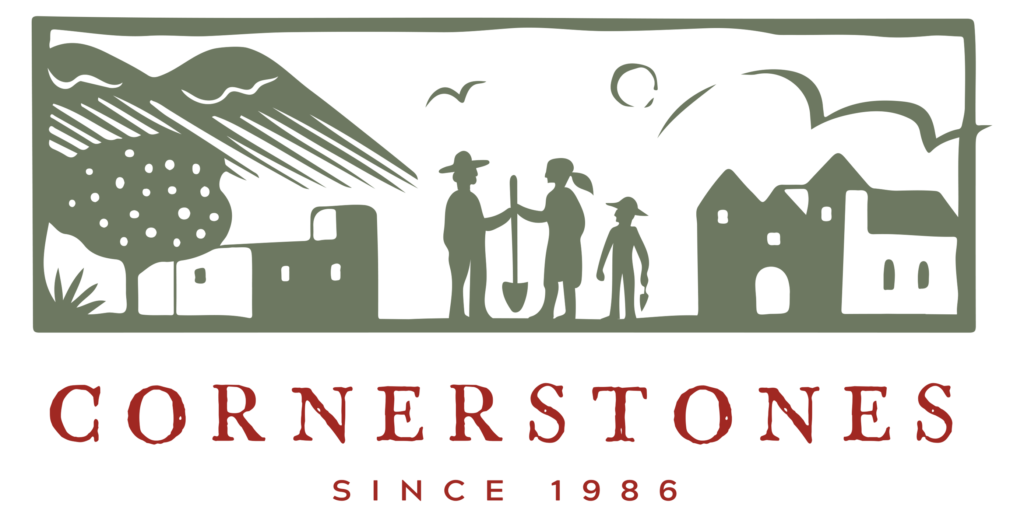The story of New Mexico’s Penitente Moradas is fascinating and quintessentially New Mexican. Their history illustrates another case where New Mexicans defined for themselves the form that organizations in their community would take. The Penitente brotherhood (Hermanos) is a lay association of Catholic men who have a spiritual practice and provide a wide variety of services to their communities. Their traditions have a foundation in the Spanish Catholic Church but over time and distance they transformed to meet the needs and reflect the character of Northern New Mexicans. The Moradas are meeting houses where their spiritual ceremonies and some other community gatherings take place. I had read that visitors outside the Brotherhood cannot enter a Morada, but that was not my experience in Abiquiu one day last spring.
A foundational part of Cornerstones model is partnering with communities in a way that our role is shaped by what the community feels they need most. Many of you have seen the Abiquiu Alto Morada which sits alone on a bluff with an impressive view. In 1992, the building was vandalized. The Hermanos engaged Cornerstones to collaborate with them to raise the funding they needed to repair the Morada. Cornerstones’ files on Abiquiu are a testament to how beloved this Morada and the community are. The documents in the files show that there was a benefit auction, a specially commissioned poster, and several children reached into their piggy banks. All of this was part of an incredible and successful effort to restore Abiquiu’s Alto Morada.
Click to zoom.
The Hermanos carried out the restoration project so swiftly that they were able to use the Morada for Ash Wednesday services in February of 1993 and completed all the work in time for Holy Week services that April. Sam Baca, the Director of the organization now known as Cornerstones, notes that the Hermanos themselves accomplished a great deal of the work that normally might have been done by a contractor.
Today, Cornerstones and the Abiquiu community are again working on a Morada. But this is a different Morada. Abiquiu has two. The Moqui Morada is also sometimes referred to as the Women’s Morada. Now, that got our attention! In most, if not all communities, members of the Women’s Group are the helpers or Ayudantes for the Hermanos. In the case of this Morada, they are in charge of it.
On a beautiful April day, I visited the Women’s Morada with Jake Barrow, Angela Francis, Anne Galer, and Barb Odell. Theresa Jamarillo hosted us. Theresa has cared for the Morada since 1996 as the head of the Women’s Group. Her relationship with the building goes much further back. She shared that when she was 8 years old she took a pledge to care for the Morada.
During the tour we discussed many technical aspects of the building and what types of repair it might need. Last year Anne, an architectural preservationist specializing in adobe building conservation, wrote a historical and structural report for Cornerstones on the Morada. She brought a great deal of context to our tour. It is also obvious that she has built a wonderful relationship with Theresa over the course of her research. Angela is a talented and skilled adobe plasterer with an impressive eye for what is going on with the building and potential solutions. In the background, Barb Odell documented our visit and the condition of the building. She even brought a drone so we could safely get pictures of the roof.
We were also joined on our tour by Dexter Trujillo. Dexter manages the Alto Morada and has connections to the Women’s Morada. He brought a great deal of history to the conversation. His greatest gift to us came as we concluded the tour. Anne requested that Dexter sing the “Madre Dolores” aria. I cannot possibly convey in text the magic of his rich voice on the adobe walls. That moment was confirmation of why Cornerstones exists: the physical structures like the Morada need to be cared for so that the intangibles of culture and community, like Dexter’s song, can also survive and thrive.
Abiquiu Women’s Morada Exterior
Abiquiu Women’s Morada Exterior
Roof of the Morada, photo taken using a drone
Anne Galer, Angela Francis, Tracey Enright, Dexter Trujillo, Theresa Jaramillo, Teresa Jaramillo’s sister, and Jake Barrow
If you would like to support our work at the Abiquiu Morada and other projects like it, please use the button below to donate online, or go to https://www.cstones.org/donate
If you prefer to donate by check, please use the address below:
Cornerstones Community Partnerships
P.O. Box 2341
Santa Fe, NM 87504-2341
Thank you to Barb Odell for allowing me to use her images and bringing her drone!
The history of Abiquiu and its Moradas is fascinating and complex. I have not done it justice in this short article. If you want to dig into the story, I suggest you get a copy of Richard Ahlborn’s, The Penitente Moradas of Abiquiu. You can read it online via Project Gutenberg (https://www.gutenberg.org/files/44678/44678-h/44678-h.htm) or at the Santa Fe Public Library in their reference collection. Anne Galer recommended it to me. Her work and Ahlborn’s were essential to me for this piece. Thank you Anne.
Tracey Enright, Executive Director
Photos Barb Odell, All Girls Media

